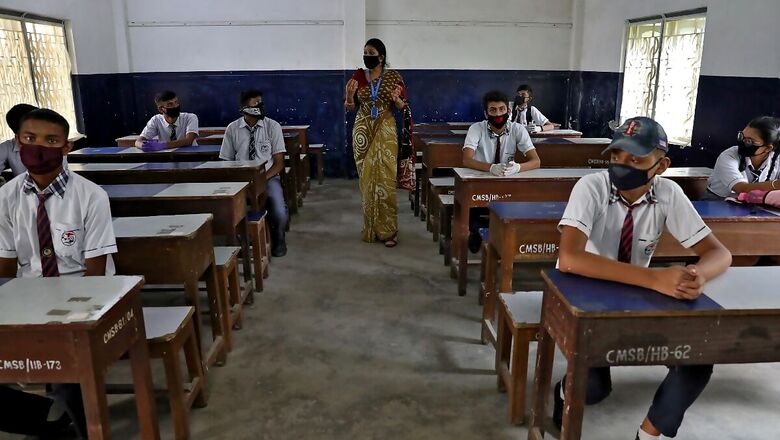
views
With school closures and classes continuing, hybrid or blended models of learning stressing on offline components are being practised in remote parts of the country. Non-governmental organisations working in various states have signed memorandums of understanding (MoUs) at district or state level and found a terrain tough for tutorials. While sharing their experiences on working in these regions, one of the groups said that without the offline component in blended approach, 85% children would have suffered from learning loss.
Digital disparity in numbers
To start with the access issue. The ChildFund, a development organisation working in remote areas of fifteen states, across 30 plus blocks of the country, said “access issues” are widely prevalent in all regions. According to the data shared by it, only 40% in the communities the group is working with have any kind of smartphone or laptop available at their homes.
But this figure includes families where a young elder brother or an uncle would have a smartphone. The probability of the phone being available to the children for their online classes is much less.
So when they segregate data for rural locations and also consider the availability of devices, “only 8 -10 per cent children would have any kind of access to devices for their learning,” said Aekta Nandwana Chanda, Technical Specialist Education with ChildFund.
The story of inaccessibility in numbers was shared by another organisation working in various districts in the country as part of MoUs signed between local authorities and them. Pearl Tiwari, director and CEO Ambuja Cement Foundation, said, “With regard to the current situation of conducting online education in rural areas, we have seen only 60% of our children attend online classes."
The communities are always grappling with network connectivity issues. While some households own one smartphone, they have 2-3 children who need online education access.
Tiwari added that in the tribal belts, because of significant presence of lower-income groups, sometimes smartphones are unaffordable and electricity is unavailable 24x7 leading to low battery issues.
There is lack of infrastructural support as well. “While schools were very well versed with infrastructure and the system prior to lockdown, unfortunately now due to their closed doors they do not have the capacity to incorporate digital learning. This is a big infrastructural issue faced in rural areas for which we need to bridge the gap by collaborating together and coming up with solutions,” Tiwari said.
Offline-dependent online education
ChildFund initiated a response in terms of support as early as mid- March after the announcement of partial closure of schools. They focused on supporting the children by providing books from their libraries and also some worksheets, but gradually the organisation developed a full-fledged intervention, 'Intergenerational Coping and Learning intervention', which also had an online component.
“We realised quite early in our intervention areas that online is going to be a big challenge as most of these families did not have access to the internet, smartphones and laptops,” said Chanda.
As part of this intervention, they provided well-sanitised storybooks from their libraries on a rotation basis, printed worksheets on language and mathematics as well as specially designed activity booklets to help them deal with their social emotional states during this crisis, a kit with stationery, art material board games, indoor play equipment like ropes, etc.
“Use of a blended approach which is more tilted towards the offline solutions has worked better. So what we had was, storybooks, conversation charts, workbooks, worksheets as well as ensuring a component of contact either through phone calls, wherever possible home visits even if it was just once a week visit, and including the local youth in supporting these initiatives along with the teacher,” said Chanda.
Another offline component is supporting the parents in helping the children continue their learning by ensuring a daily routine, engaging in activities like storytelling, having very small groups of children sitting with physical distance and giving work on workbooks, etc. “85% children would have nothing to support their learning if the offline solutions were not added to the blended approach,” said Chanda.
On the other hand, ACF is pursuing a fully online mode in most of its programmes in various states but in challenging rural areas it is dependent on offline methods to enable education. For instance, in around 2-3 schools in Chandrapur they are using a blended approach. The region has open spaces so they are conducting classes with social distancing norms being followed.
“Even some Balmitras who live closer to the Jiwati area are able to visit some of the students but not always. In our approach, 10-15% of imparting education is offline. These decisions are taken based on the circumstances while the rest is all online,” said Tiwari. In Roorkee, with the help of digital smart learning class, the teachers are working in collaboration with Balmitras of the community to organise group classes.
Tiwari also shared that in tribal areas which are known for poor network availability, “the teachers themselves are visiting these areas and conducting group classes with 5-6 children adhering to all precautionary measures”.
Girl students lose out
Both these organisations observed that girls are disadvantaged in the digital education model. “There is a high dropout rate of girl students," said Tiwari.
Chanda added, “Access issue means availability of no device like smartphone or laptop in the household. Even if there is some device available in the family, the chances of it being available to the children are very slim and the girl children are at a further disadvantage in this situation. Then availability of network... in remote areas the availability of network also is a huge challenge.”














Comments
0 comment